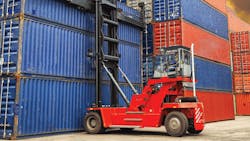U.S. LOGISTICS - Slow Growth Is Good Growth in the Era of the New Normal
One trillion dollars. That's roughly how much U.S. businesses spend every year on logistics. In fact, the actual amount spent in 2012 was $1.331 trillion, which was an increase of $43 billion from 2011 (a growth rate of 3.4%). To put that number into perspective, $1.3 trillion equals 8.5% of the U.S. Gross Domestic Product (GDP). While the U.S. economy may still be in a state of torpor, the amount spent on logistics in 2012 was the highest since 2008's $1.344, and the third highest ever.
As the recovery-that-doesn't-feel-like-a-recovery continues, it's time to ask if this is the new normal, says transportation analyst Rosalyn Wilson, author of the annual State of Logistics Report on behalf of the Council of Supply Chain Management Professionals (CSCMP), and presented by Penske Logistics. "We are experiencing a new order that is translating into the new way of life for the economy and the logistics and supply chain sectors for the foreseeable future," she adds.
That new order, she suggests, is characterized by slow growth; higher unemployment; slower job creation; higher healthcare costs; and more reliance on part-time workers who do not receive benefits. Freight service has become less reliable as volumes begin to rise, but capacity is not increasing quickly enough to fully meet demand. "The single biggest accomplishment resulting from the Great Recession," she says, "is the increased productivity across almost all sectors of the economy. Everywhere we have learned to do more with less."
In that vein, shippers are certainly learning to cope with less capacity, particularly when it comes to motor carriers, which account for 70% of all goods transported in the United States as well as 80% of all transportation costs. The recession saw many trucking companies go under, and recent government regulations—requiring new, environmentally-friendly engines while shortening the amount of time drivers can be behind the wheel—have made it more expensive for the remaining carriers. While there is no immediate danger of shipments being left at the docks for want of an available truck, there are unmistakable warning signs on the horizon that shippers will need to closely monitor.
Diminished Capacity
The first warning sign is the tightening of truck capacity. According to Wilson, utilization rates are at all-time highs, between 95-97%. On top of that, the new Hours of Service (HOS) rules, which went into effect on July 1, "represent a theoretical 17% reduction in a standard work week," she notes. "Estimates abound on the actual impact of the new HOS, but fall somewhere between a 2% to 10% productivity decrease."
But hold on, it gets even worse. The HOS rules could also result in a 2% to 5% reduction in driver capacity, a particularly nettlesome occurrence given that the industry is already short by about 30,000 drivers. And don't look for the motor carriers to compensate for the capacity gap; according to advisory firm Transport Capital Partners, 76% of carriers surveyed plan to add little (1% to 5%) or no capacity in the coming year. Only 24% of carriers say they plan to increase capacity by more than 5%. And of that number, only 19% of larger carriers plan to add more than 5% capacity, says Richard Mikes, TCP partner, with the smaller carriers being more likely to add another truck or two to their fleets.
Considering that the trucking industry is at or near a 100% turnover rate for truck drivers, the labor costs to attract and retain drivers could jump quickly as experienced drivers change jobs in search of better pay, Wilson (who also provides analysis for the Cass Freight Index report) observes. Although rail/intermodal can absorb more freight, she believes truck shortages could become a serious problem as we enter the fall months.
"Shippers expect trucking capacity to tighten broadly, with truckload capacity to tighten the most," observes William Greene, senior transportation analyst with financial services firm Morgan Stanley. And tighter capacity inevitably leads to two things: rate increases and mode shifts. According to the latest Freight Pulse survey of shippers, conducted by Morgan Stanley and MH&L, expect to see shippers moving more of their freight to rail and intermodal, and as a result, rates for those two modes are expected to rise by more than 3% over the next six months (see chart at left).
In another study of shippers, this one conducted by the National Shippers Strategic Transportation Council (NASSTRAC), nearly eight out of ten (79%) respondents say they have shifted freight from one mode to another, with a shift to rail/intermodal (38%) being by far the most prevalent (see chart on pg. 19). Forty-two percent of respondents said the main reason for shifting modes is cost savings, and what's more, 58% anticipate executing a modal shift at some point in 2013.
Logistics a la Mode
While rising rates on the rails is far from good news for shippers, it's at least moderately comforting to know that the railroads are in "very good shape from an infrastructure, equipment and personnel basis," says Wilson. Costs for rail transportation were up by 4.9% in 2012, but that's actually a positive sign since rates had jumped by 16% the year before. While total carloads for the year fell 3% compared to 2011, Wilson points out that "intermodal volume was the second highest on record."
Air freight costs were up by 3% in 2012, although total tonnage was down by 2% (most of the decline was on international air, which declined by 1.4%, while domestic air was down just 0.1%). "The air cargo industry has been facing chronic overcapacity and deteriorating yields," Wilson says, a situation exacerbated by an increase in cargo volumes riding as belly cargo on passenger jets. "Belly cargo is very profitable, estimated at close to 65%, so passenger airlines have been pursuing it more aggressively," she explains.
As for the other modes, freight forwarder costs were up 5% in 2012, while oil pipeline costs were up 8%.
Approaching Critical Levels
The most recent Cass Freight Index report, which tracks both shipments and expenditures on a monthly basis, saw shipments increase by 0.09% in June 2013 compared to the previous month, which were down -1.5% from June 2012. However, expenditures on freight were up 3.4% compared to May 2013, and up 0.08 compared to June 2012. "Cumulatively for 2013, the number of shipments is up 5.8%, but second-quarter growth was much slower than first-quarter growth," Wilson notes.
Another monthly index, the Shippers Conditions Index, monitored by FTR Associates, assigns a score to the current environment for shippers. Any score over 0.0 is positive conditions, while a score below zero indicates a less-than-ideal situation. The current score, according to FTR, is -7.5, which is not only considerably lower than zero but is getting close to -10, a score that signals that conditions are reaching critical levels, both for available capacity and expected carrier rates.
"The sluggish economy and freight environment that has persisted for nearly two years now has created an environment in which shippers have been able to secure low rate increases despite fleets operating with fairly small amounts of spare capacity," notes Jonathan Starks, FTR's director of transportation analysis. "The introduction of more restrictive Hours-of-Service regulations for drivers on July 1 means that the amount of excess capacity in the system has shrunk even more. As long as freight levels continue to inch upward, truck rates are likely to begin a more significant pattern of increases. If nothing else, fleets will be looking to cover their increased operating costs for drivers, in addition to taking advantage of the reduction in spare capacity that generally drives upward movement in truck rates."
According to Starks, shippers should expect to see an acceleration in rates for the second half of the year, coinciding with the new Hours-of-Service rules taking capacity out of trucking. These negative factors will result in a continuing decline in the Shippers Conditions Index. Whether or not the index makes it to the dreaded -10.0 score, though, remains to be seen.
Sure Could Use a Little Good News
So is there any good news for shippers on the horizon? Actually, yes, according to Wilson's State of Logistics Report, if we accept her premise that we need to readjust our understanding of "good news" in the era of the new normal. As noted earlier, the railroads have reemerged as a viable, and affordable, option for some shippers. While the Morgan Stanley/MH&L Freight Pulse study indicates that rail service reliability has been trending lower over the past six months, value for dollar has remained steady.
The new normal has also changed the way we manage and distribute inventory, Wilson notes, thanks to the rise of online shopping. "Real-time transparency in our distribution networks allows us to fulfill orders faster with less inventory. The same inventory is used to fill store orders and online orders. If the store doesn't have the item in the color or size you want, your order can be placed right at the store." True, consumers tend to be more cautious about how they spend their money, trending more toward saving than spending their disposable income, but at least when they do spend, they're finding a more efficient, multi-channel supply chain ready to fulfill their orders.
The U.S. unemployment rate hit a four-year low in July 2013, so that's good news. On the other hand, most of the new jobs being created these days tend to be short-term, part-time jobs with no benefits, so those in the workforce who haven't given up looking for work often end up taking two or three part-time jobs just to retain a semblance of the lifestyle they enjoyed in the pre-recessionary days.
Looking at the current logistics landscape of very slow growth, lowered consumer confidence and tightening capacity, Wilson points out that "these are the same trends we have contended with for the last three years and they will be with us for at least the next three." Perhaps, she suggests, we should consider the possibility that this is about as good as the "recovery" is going to get.
About the Author

Dave Blanchard
Senior Director of Content
During his career Dave Blanchard has led the editorial management of many of Endeavor Business Media's best-known brands, including IndustryWeek, EHS Today, Material Handling & Logistics, Logistics Today, Supply Chain Technology News, and Business Finance. He also serves as senior content director of the annual Safety Leadership Conference. With over 30 years of B2B media experience, Dave literally wrote the book on supply chain management, Supply Chain Management Best Practices (John Wiley & Sons, 2021), which has been translated into several languages and is currently in its third edition. He is a frequent speaker and moderator at major trade shows and conferences, and has won numerous awards for writing and editing. He is a voting member of the jury of the Logistics Hall of Fame, and is a graduate of Northern Illinois University.



